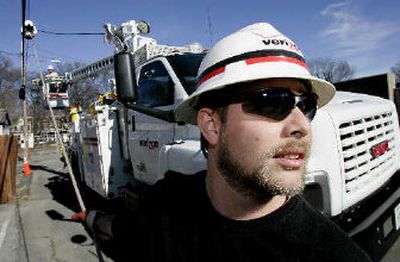Verizon hits a few bumps

RICHMOND, Va. — In Pat Wilcox’s yard, Verizon workers laying the groundwork for a revolution in communications quickly turned their efforts to a more pressing project: putting out a fire they sparked by crossing two electric wires.
By the time firefighters arrived, the wind-whipped flames had engulfed overhead utility lines and melted a chain-link fence.
“There wasn’t much anybody could do till the fire department got there,” said Wilcox, whose son’s canoe was ruined in the March blaze in suburban Richmond. “It was burning so hot.”
The damage bills won’t be the last paid by Verizon Communications Inc. as it continues with its largest-ever construction project, which involves replacing a copper-wire network with fiber-optic cables.
New York-based Verizon is spending billions on the upgrade so its network can deliver video on demand and hundreds of channels of high-definition television, as well as Internet connections hundreds of times faster than most broadband lines. So far, the path to the future has been marked by more than a few ruptured utility pipes, split cables and dug-up driveways.
Verizon officials acknowledge startup problems with their FiOS project, but they add they have seen a dramatic decline in the number of damage incidents since it began in 2004.
“It was definitely growing pains for us,” said Chris Creager, Verizon senior vice president for operations in the mid-Atlantic region.
Some officials and utilities agree that Verizon’s performance has improved, but they add this often came after stern warnings, halted jobs and stiff penalties. Others say complaints, even if fewer in number, are to be expected wherever the project moves and especially in communities with mostly underground pipes and cables.
“They want to do a lot of work quickly and that’s where the problems start,” said Thomas Rawls, a professional engineer in the public works department of Hillsborough County, Fla., which ordered Verizon to temporarily stop work after a series of waterline breaks in 2004.
Verizon’s project has forced communities to hire people to monitor work and to protect their facilities — such as electric, gas and water lines.
Rawls, for instance, hired 10 temporary inspectors for about $500,000 a year and a consulting firm for another $150,000. In Anne Arundel County, Md., where Verizon hit hundreds of underground lines in its first few months of construction last year, three additional inspectors were hired, said Alex Baquie, a local public works official.
At one point, Verizon was striking 10 or 11 lines per 10,000 feet — a common industry measure.